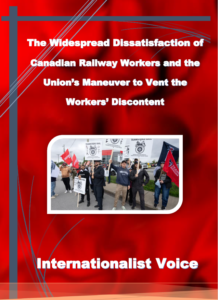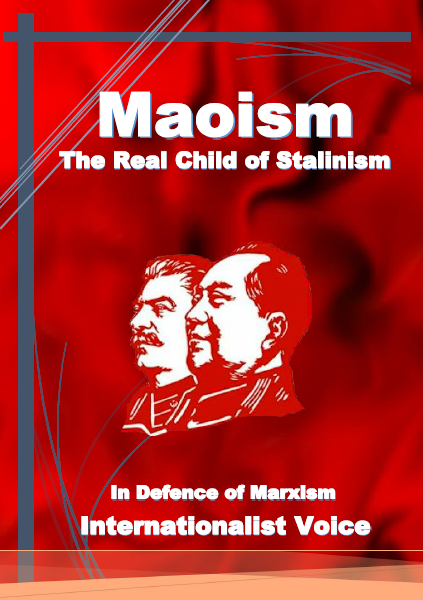The Widespread Dissatisfaction of Canadian Railway Workers and the Union’s Maneuver to Vent the Workers’ Discontent
Everywhere, whether in metropolitan or peripheral capitalism, the bourgeoisie attacks the working conditions and living standards of the working class for greater profit, and this raises discontent and anger among the workers. Dissatisfaction has long been brewing among Canadian railway workers due to their unsettled working conditions. They object to the terms of their employment, especially the schedule; they worry that long shifts reduce the 24-hour rest period after each one, which in turn undermines work safety and enhances the possibility of derailments, as well as affecting other aspects. It increases work accidents, so the workers want a new contract in which their safety will be improved. These protests are not even to raise their standard of living but to secure better working conditions.
Working conditions for wage slaves in advanced Canada are no better than in other countries. Workplace accidents there occur in significant numbers every year. For example, in 2021, approximately 264,438 occurred that involved workers, and the injury rate during this period was generally between 2.0 and 2.5 per 100 employees.[1] The fact is, news of workplace accidents is rarely reported in newspapers or mass media, and the director of public relations for Teamsters Canada makes this clear:
“Every year across the country, there are hundreds of derailment cases of runaway trains, fires, explosions. And these incidents, they rarely make the news, but they happen.”[2]
Canada is the second-largest country in the world in terms of area, and transportation by rail is very important. Canada’s railways transport approximately $1 billion in goods per day, and their disruption would disrupt the supply chain in North America, in other words, not only affecting shipping in Canadian ports, but also US railways. In 2022, the value of goods moved by Canadian railways was approximately 380 billion Canadian dollars. A one-week strike on Canadian railways could cost approximately a billion dollars, and a prolonged strike would affect not only the Canadian economy, but also those of other countries that rely on Canadian exports.
In Canada the International Brotherhood of Teamsters in Transportation has approximately 9,000 members and has long been under pressure from the workers to strike, with talks between the union and the railway companies going on for the past nine months. In this regard, when they voted to strike for a new contract in May, 90% of the workers showed up and 98% of them chose to strike again.[3] According to Canada’s labor law, the workers’ vote for a strike by the union is only valid for two months, and after that period, it must be voted on again. At that point, the federal labor minister was able to prevent the strike by intervening and asking the Canadian Industrial Relations Board to investigate whether such a strike would still occur “should any safety-critical needs be identified.”[4]
On the one hand, the Canadian bourgeoisie has been aware of the workers’ dissatisfaction with their working conditions due to work incidents in recent years, but on the other, the strikes by the railway workers in 2012 (nine days), 2015 (two days), 2018 (16 hours ), 2019 (eight days) and 2022 (60 hours), although the strikes were short-lived. The huge amount of discontent that had accumulated among the workers had to be channeled and vented before it exploded. The role of the union becomes vital in such situations.
Following the failure of negotiations between the International Brotherhood of Teamsters, the Canadian National Railway (CNR) and the Canadian Pacific Railway Company of Kansas City (CPKC) regarding a new contract, both companies sent workers and railway personnel into a lockout on August 22. Following this, the movement of freight trains and some passenger trains was suspended, which had a huge impact on transportation in the three largest cities of Canada, Montreal, Toronto and Vancouver. As of August 23, Canadian National Railways resumed service, but Canadian Pacific Railway workers in Kansas City were on a forced lockout. After trains began running again on August 23, the teamsters issued a 72-hour strike notice. In Canada, three days’ notice of a legal strike through a trade union is a legal requirement for an employer to prepare for a strike. In other words, the strike was supposed to start on August 26. The trade union wanted to channel the latent anger and dissatisfaction of the workers through a pre-planned strike, and prevent the formation of an independent labor struggle and strikes. The bourgeois government did not allow even this.
The Canadian government declared that the economic risk was too great, so it forced the parties to binding arbitration; in other words, it issued an order to end the shutdown. Subsequently, Canada’s labor minister asked the Canadian Industrial Relations Board to apply binding arbitration to resolve the dispute between the railway companies and the Teamsters Canada Rail Conference (TCRC), that is, despite the dissatisfaction of the workers, pressure them to accept an arbitration agreement and thus defeat the workers’ protests.
Section 107 of the Canada Labor Code allows the government to refer a labor dispute to the Canada Industrial Relations Board, the country’s labor court, for mandatory arbitration. The union and the two railway companies held a nine-hour arbitration hearing with the Canadian Industrial Relations Board.
The union questioned the government’s action before the board. But Ginette Brazeau, chair of the Canadian Industrial Relations Board, acknowledged that she lacked the authority to refuse or vary orders given by the minister, meaning they must be carried out as ordered, writing:
“The Board has concluded that, in this case, it has no discretion or ability to refuse to implement, in whole or in part, the minister’s directions or to modify their terms.”[5]
Brazeau ordered the companies and the union to resume operations at 12:01 a.m. on August 26. Brazeau’s ruling effectively nullified the 72-hour strike notice by the union of the Canadian National Railway that was issued on Friday morning.
The mass communication media of the ruling class happily talked about the defeat of the workers, but they did not write what caused it, or in other words, how the workers were defeated and tasted the bitter taste of disappointment. For example, the Journal of Commerce reported:
“Canadian rail workers back on job after failed challenge to binding arbitration.”[6]
François Laporte, the head of the labor union, stated that he does not agree with the binding arbitration of the minister of labor, but that the union will follow the decisions of the Canadian Industrial Relations Board, writing in his statement:
“The TCRC will lawfully abide by the decision, but will undertake steps to challenge to the fullest extent.”[7]
François Laporte emphasized that this challenge is not about disobeying the minister’s order, but what role will the workers play in it? How will it work within the legal framework? The essence of the matter is that the workers are left out of the protest process and this task is assigned to the union. The union will also ask the federal court to reconsider its decision if necessary:
“We will exercise our right within the legal framework.”[8]
In other words, they are dragging the struggle from the workplace and from the street, where the workers will be in a collective form, to the courtroom, where the lawyer and the judge will face each other. Although the binding arbitration ruling of the Canadian Industrial Relations Board started on August 29, on August 26, the workers were forced to return to work thanks to the services of the trade union to the bourgeois government. The workers endured another round of disillusionment, although discontent and protest among railway workers are still very high.
The problem is not François Laporte’s incompetence, but the structure and performance of the union against the working class. Mick Lynch, leader of the National Union of Rail, Maritime and Transport Workers (RMT), who is also much more radical than François Laporte, has done worse to British workers before.
“RMT joins the whole nation in paying its respects to Queen Elizabeth. The planned railway strike action on September 15 and 17 is suspended. We express our deepest condolences to her family, friends and the country.”[9]
In a situation where the class struggle is reviving at the global level, diverse bourgeois tendencies are offering alternatives to contain the class struggle. The Canadian bourgeoisie is aware of the potential of the working class and the maneuvers of the teamsters trade union are intended to channel the protests of the workers in order to drain their latent anger and dissatisfaction and prevent the formation of an independent labor struggle and strikes.
The task of labor unions is to manage the sale of labor. It is only through class struggle that it is possible to challenge capitalism at the same time while fighting to raise living standards, job security and work safety.
In the current situation, the independent struggle of workers outside the framework of unions and in its process through factory committees, general labor assemblies and other independent labor institutions is the method of labor struggle that will take the form of labor councils as the class struggle evolves and intensifies.
Long live the independent labor struggle, separate from any capitalist institution!
The future belongs to the class struggle!
Joseph
27 august 2024
Notes:
[1] Association of Workers’ Compensation Boards of Canada















